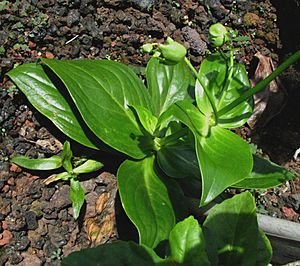Na Pali Beach starviolet facts for kids
Quick facts for kids Na Pali Beach starviolet |
|
|---|---|
 |
|
| Kadua st.-johnii | |
| Conservation status | |
| Scientific classification | |
| Kingdom: | |
| (unranked): | |
| (unranked): | |
| (unranked): | |
| Order: | |
| Family: | |
| Genus: |
Kadua
|
| Species: |
K. st-johnii
|
| Binomial name | |
| Kadua st-johnii (B.C.Stone & Lane) W.L.Wagner & Lorence
|
|
| Synonyms | |
|
Hedyotis st-johnii B.C.Stone & Lane |
|
Kadua st-johnii, also known as the Nā Pali beach starviolet, is a very rare flowering plant. It belongs to the coffee family. This special plant is found only in Hawaii, specifically along the Nā Pali coast on the island of Kauai. Because it is so rare, the United States government has listed it as an endangered species. This means it is at high risk of disappearing forever.
Contents
What Does the Nā Pali Beach Starviolet Look Like?
This plant is a succulent perennial herb. This means it has thick, fleshy parts that store water, and it lives for more than two years. Its stems are squared and trail along the ground.
The leaves are also fleshy and grow mostly near the bottom of the stem. Its flowers grow in clusters. Each flower has a tube-shaped group of green petals, called a corolla.
Where Does This Rare Plant Live?
The Nā Pali beach starviolet grows on cliffs that face north. These cliffs are found above the beaches of the Nā Pali coast in Kauai. The plant grows low enough on the cliffs to be regularly sprayed by sea spray from the ocean.
Other plants that share this habitat include:
- Naio (Myoporum sandwicense)
- Kawelu (Eragrostis variabilis)
- Ohelo kai (Lycium sandwicense)
- Pili (Heteropogon contortus)
- Ahinahina (Artemisia australis)
- Akoko (Chamaesyce celastroides)
Why Is the Nā Pali Beach Starviolet Endangered?
This plant is in great danger. By 2004, there were only three groups of these plants left. They were found at Milolii, Kalalau, and Nualolo. In total, there were only about thirty plants in the entire world! Later that year, two more plants were found on a cliff at Awaawapuhi.
Main Threats to the Plant
The biggest problem for the Nā Pali beach starviolet has been damage from feral goats. These are goats that have escaped from farms and now live in the wild. They eat the plants and destroy their habitat. Today, the plant can only survive on very steep cliffs where the goats cannot reach.
Another major threat comes from invasive plants. These are plants that were brought to Hawaii from other places. They grow quickly and take over the space and resources that native plants like the Nā Pali beach starviolet need to survive.
Some of these harmful invasive plants include:
- Sourbrush (Pluchea carolinensis)
- Lantana (Lantana camara)
- Daisy fleabane (Erigeron karvinskianus)
- Haole koa (Leucaena leucocephala)
- Billygoat weed (Ageratina conyzoides)
- Hairy spurge (Chamaesyce hirta)
These threats make it very hard for the Nā Pali beach starviolet to grow and reproduce. This is why it is so important to protect this unique Hawaiian plant.


